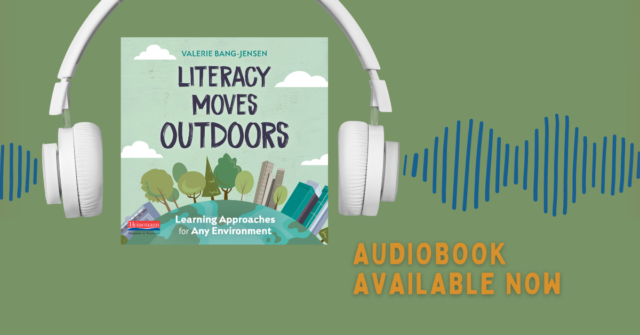
In Teaching Literature In The Context Of Literacy Instruction, coauthors Jocelyn Chadwick and John Grassie explore how the familiar literature we love can be taught in a way that not only engages students but does so within the context of literacy instruction, reflecting the needs of today’s classrooms. They address complex questions secondary English teachers wrangle with daily: Where does literature live within the Common Core’s mandates? How can we embrace informational texts in our literature classrooms? And most importantly, how can we help students recognize how canonical works are relevant to them?
In today's blog, the authors discuss the thematic through lines of literature, and how to get students interested in canonical works.
The Old and the New: Blending Narrative Journeys Into the Human Condition
by Jocelyn Chadwick and John Grassie
Just what do our students see and what do they think, how do they process canonical works of literature we know are valuable not only as monumental literary texts but also life-lessons articulated through words and images and stories? Novel, short story, drama, poem—canonical fiction can argue, cajole, provoke, satisfy, reflect, project who we have been, who we are, who we desire to be. The issue for our students? It is old. The authors are dead. The language is different. These books are irrelevant today. But in reality, the Canon is anything but unrelateable, irrelevant; this literature is an essential part of our world. What our students don’t yet understand is that modern and contemporary fiction relies on those themes explored so very long ago.
The difference, of course, is each author’s unique signature, or redaction, to each theme. Jealousy, an age-old theme, written about and redacted upon by writers from our canonical past undergo further redactions by modern and contemporary writers addressing our immediate present: Chaucer (Troilus and Criseyde), Shakespeare (Othello and Julius Caesar, for example,) Morrison (Jazz), Kirby (Nothing Gold Can Stay), or Cass (The Elite). The theme of identity: Aeschylus (Prometheus Bound), Euripides (Medea) Shakespeare (The Taming of the Shrew and Merchant of Venice), for example; Hawthorne (The Scarlet Letter), Wilder (Our Town), Hansberry (A Raisin in the Sun), Joyce (Portrait of the Artist as a Young Man), Alexie (The Absolutely True Diary of a Part-Time Indian). Each redaction, each “variation on the theme” reflects the period and people from which it emanates.
Our human story, our narrative skeleton, has not changed; the tree of human experience has grown many, many branches.
Essentially, all literature depends upon thematic threads to convey its message. The themes are those that reflect the human condition. Our human story, our narrative skeleton, has not changed; the tree of human experience has grown many, many branches, however, while the trunk remains strong and cohesive. All emanates from the trunk of this tree. Take for example the theme of the struggle—a human theme that can literally encompass all four types of conflict (the individual vs. others, the individual vs. society, the individual vs. self, individual vs. nature). The Odyssey (Homer), Rime of the Ancient Mariner (Coleridge), The Grapes of Wrath (Steinbeck), Their Eyes Were Watching God (Hurston), The Old Man and the Sea (Hemingway), Native Son (Baldwin), and God Help the Child (Morrison) all share the theme of struggle. Canonical and modern/contemporary, rich in diversity of all types and yet all sharing the same fundamental thematic thread. No, the endings are not pretty bow-wrapped and happy; rather, each work reflects the decisions and struggles and consequences experienced.
If students today read many of these works without additional contexts they recognize as relevant, however, they potentially remain siloed—unrelateable, distant, irrelevant, meriting only enough study either to take the test or write the obligatory essay. We can avoid this silo tendency by backing into these works and by blending newer, including YA fiction, as parallel, or companion texts.
A recommended approach teaching a work like Portrait of the Artist as a Young Man, with its stream of consciousness narrative, through Stephen’s eyes and mind, we too, see and experience difference, marching to a different rhythm. And yet it is this very difference that makes him unique, enables him to develop and hone his voice and identity. Many of Sherman Alexie’s works, for example, focus on identity and voice, providing an engaging pathway to back into this brilliant work. Equally effective is using artists who have walked individual paths, not always readily understood or accepted.
While some lament that the literature we love is under assault and we can do nothing about that assault, like Lear raging against the storm, we must acknowledge the opposite! We are in the midst of a push for literacy that we have not witnessed before—social, cultural, global, political, communal—all forms—college, career, everyday living. That we do teach literature, that we most assuredly do understand how literature speaks and informs from the past into our immediate present must be our rallying cry for our students, for they, above all, will benefit if we are successful. As ELA teachers, we stand at the forefront of this change—this wonderful change. The Canon has never been more needed and prescient for our students than it is today. Blended with modern and contemporary texts, the Canon not only illustrates its import but its relevance as well.
We now live in a time where our students are besieged with concerns.
In so many ways, the Canon has always informed and provided a “jumping-off point” for all literature. The Bible, the Koran, the Torah, Greek and Roman and Egyptian myths, myths from all cultures, epics, dramas—all explore the human condition through narrative. We make meaning through narrative, and classical literature has sought to speak to us through these narratives.
We now live in a time where our students are besieged with concerns, conditions, environments, situations, and sometimes, daunting challenges. Our students do not live in a Leave it to Beaver or Father Knows Best or any other fictionalized happy television program, making audiences feel comfortable that all will be well; all issues will be handled; all conflicts abated. A parent once said, “I want my child to read happy literature, like life is supposed to be.” Well, we teach literature, even fairy tales that aim to take the reader on a human condition journey. This narrative journey may, at times, be in the reader’s face and uncomfortable, or it may appear to be adventuresome with no great thought required. But we know that literature aims to teach and instruct and expose. Most importantly, canonical literature provides a distance between the fictional world and the reader, thereby, allowing, even supporting, a safe space for self-exploration.
Blending canonical texts with modern and contemporary texts, media, art, music allows, even encourages students to read more deeply and see for themselves where they fit into society, allows them to weigh and think about the Canon in ways they have never before. In essence, by removing the silos and empowering our students to assert their views and perspectives, we privilege them to own their learning and to claim the Canon as their literary legacy, too.
Click here to learn more about Teaching Literature In The Context of Literacy Instruction.
♦ ♦ ♦ ♦


Jocelyn A. Chadwick has been an English teacher for over thirty years—beginning at Irving High School in Texas and later moving on to the Harvard Graduate School of Education where she was a professor for nine years and still guest lectures. Dr. Chadwick also serves as a consultant for school districts around the country and assists English departments with curricula to reflect diversity and cross-curricular content. For the past two years, she has served as a consultant for NBC News Education's Common Core Project for Parents, ParentToolkit. In June 2015, Chadwick was elected Vice President for the National Council of Teachers of English.
John Grassie is a veteran broadcast journalist, with more than 25 years’ experience producing news coverage, program series, and documentaries for Public Television, NBC News, and Discovery. During his broadcast career, Grassie’s work received numerous awards for excellence in journalism.


